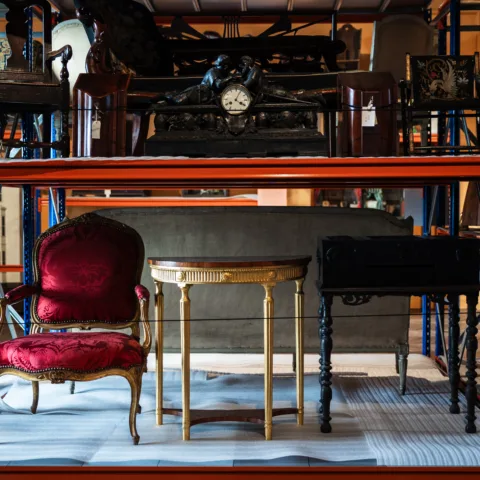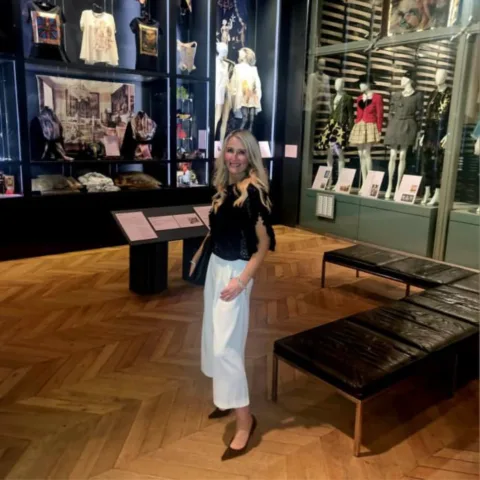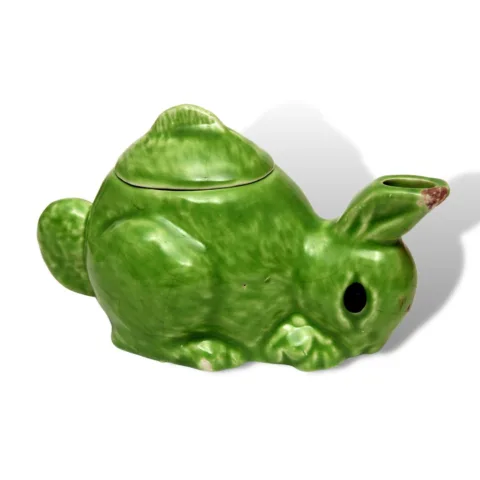The Bowes Museum Blog

On the Workbench This Week
We are starting some really interesting conservation treatments, so would like to give you a brief introduction to the objects and what we are planning to do.
My first object this week is a small 18th Century raised-work embroidery (EMB 3.8), it is very fragile, in need of conservation and a custom storage mount. The silk and metallic thread embroidery depicts two figures and a lion in a landscape, and measures just 22cm x 17cm. The embroidery was re-framed in the 19th century, explaining the thick adhesive, and gold paper border. The main conservation concerns for this object are the thick border, which is putting a strain on the silk, and the loss of the silk decoration on the lion and the figure’s faces.
After cleaning the surface of the embroidery, I will address the issue of the vulnerable silk decoration, which is loose and lifting from the surface. Rather than attempting to stitch these in place, I will use an adhesive to secure the threads, but first I have to do some testing to determine what is most suitable.
The paper and cracked adhesive border are the remnants of the 19th century mount, which are unsightly and may cause strain and damage to the silk ground over time. Removing the brown and gold paper border will transform the aesthetics of the object and allow more display options for the future.
The second object I am working on, is a beautiful Victor Stiebel evening dress c. 1955, which has been chosen for the Fashion & Textile Gallery re-display in 2018. The dress has a short, fitted matching jacket and its original synthetic mesh petticoat, which all need conservation. There are large areas of staining on the skirt and jacket, these are both damaging, and unsightly – they are difficult to conceal when on display. I will carry out controlled spot cleaning of the skirt and jacket to reduce these stained areas as much as possible.
It is hoped that the petticoat will go on display alongside the dress and jacket, and therefore it also requires conservation. The mesh has areas of loss (holes), and pulled seams, which will need support patches to stabilise them, preventing the damage from getting any worse. As this is quite an unusual material to work with I will need to research and develop a technique for supporting this damage. A replica petticoat will need to be made, to be used beneath the dress while on display, recreating the effect of the original.
By Emily Austin, Textile Conservation Intern
I also want to show you a couple of objects that I am starting to work on. The first is a late 17th/early 18th century silk embroidered panel (EMB.162).
It has been created using a couching technique, in silk threads on a linen ground. The landscape scene shows two men sitting in the foreground, playing the clarinet and the guitar under an apple tree. The shape of the linen, with two small areas left unworked indicates that it was made to be used as upholstery for the back of a chair. It has later been lined with red linen, with metal rings attached in the top corners, to be used as a wall hanging.
As you can see the panel is in very poor condition. It is generally soiled, with several stains on the front, and on the lining. It is creased due to poor storage. The front has large areas of loss to the couching threads, and many of the embroidery threads are disordered.
The conservation treatment proposal for this object consists of surface and localised spot cleaning – to remove the dust and try to reduce the staining. The panel will be humidified using cold steam to realign the weave, remove the creases and distortions, and organizing the threads. The panel will be stabilized with a complete fabric support, inserted between the embroidery and the lining, secured with laid-couching stitches, in colour-matched threads.
The second object I want to share with you, is one of the costume objects selected for the re-display of Fashion & Textile Gallery. This Poiret-style dress is of purple silk satin (CST.527). It has a high waistline, typical of the early 20th century, a deep plunging neckline, and an inner bodice fastened with hooks and eyes.
The collar and cuffs are finished in a colourful printed fabric. The skirt of the dress has a straight centre panel and gathers which extend to the train at the back. This dress has been altered at some stage of its history, so I will investigate the changes to its form.
Unlike the embroidery, the dress is in a fair condition. There are some stains on the purple silk and inner bodice, it is creased due to storage, with some loose seams at the front, and a large tear near the hem. The treatment proposal involves surface and localised spot cleaning, then humidification to remove the creases. The stitched treatment will include the re-stitching of the loose seams, and stabilising the tear, dyeing support fabric to match the colour of the dress. To make the dress ready for display, it will be mounted onto an acrylic mannequin.
This is just a brief introduction to some of our current conservation projects. We will keep you, dear readers, informed about the result of the treatments!
By Maria Pardos, Textile Conservation Intern






















